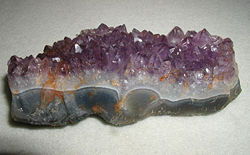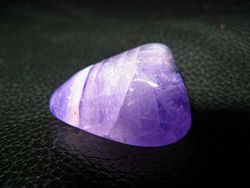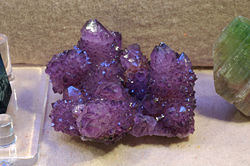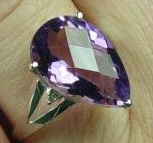Difference between revisions of "Amethyst" - New World Encyclopedia
| Line 9: | Line 9: | ||
[[Image:Quartz Amethyst.jpg|thumb|250px|Museum quality piece of amethyst.]] | [[Image:Quartz Amethyst.jpg|thumb|250px|Museum quality piece of amethyst.]] | ||
| − | Amethyst was used as a [[gemstone]] by the ancient [[Egypt]]ians and was largely employed in antiquity for [[intaglio (jewelry)|intaglio]]*s. Beads of amethyst are found in [[Anglo-Saxons|Anglo-Saxon]]* graves in [[England]]. It is a widely distributed [[mineral]], but fine, clear specimens suitable for cutting as ornamental stones are confined to comparatively few localities. Such [[crystal]]s occur either in the cavities of mineral vein and in [[granite|granitic]] rocks, or as a lining in [[agate]] [[geode]]s. | + | Amethyst was used as a [[gemstone]] by the ancient [[Egypt]]ians and was largely employed in antiquity for [[intaglio (jewelry)|intaglio]]*s. Beads of amethyst are found in [[Anglo-Saxons|Anglo-Saxon]]* graves in [[England]]. It is a widely distributed [[mineral]], but fine, clear specimens suitable for cutting as ornamental stones are confined to comparatively few localities. Such [[crystal]]s occur either in the cavities of mineral vein and in [[granite|granitic]] rocks, or as a lining in [[agate]] [[geode]]s. |
| + | |||
| + | The most commercially significant deposits occur in southern [[Brazil]] and neighboring [[Uruguay]]. Many of the hollow agates of Brazil and Uruguay contain amethyst crystals in their interior. [[Madagascar]] is the third major country to export the stone. Much fine amethyst also comes from [[Russia]], especially from near [[Mursinka]]* in the [[Ekaterinburg]]* district, where it occurs in cavities in granitic rocks. In addition, many localities in [[India]] and [[Sri Lanka]] yield amethyst. | ||
In the [[United States]], amethyst occurs at many sites, but the specimens are rarely fine enough for use in jewelry. Among these locations are Amethyst Mountain, [[Texas]]*; [[Yellowstone National Park]]*; [[Delaware County, Pennsylvania]]*; [[Haywood County, North Carolina]]*; and Deer Hill and Stow, [[Maine]]*. It is found also in the [[Lake Superior]]* region. Amethyst is relatively common in northwestern [[Ontario]]* and in various locations throughout Nova Scotia, but uncommon elsewhere in [[Canada]]. It was selected as the provincial mineral of Ontario in 1975. | In the [[United States]], amethyst occurs at many sites, but the specimens are rarely fine enough for use in jewelry. Among these locations are Amethyst Mountain, [[Texas]]*; [[Yellowstone National Park]]*; [[Delaware County, Pennsylvania]]*; [[Haywood County, North Carolina]]*; and Deer Hill and Stow, [[Maine]]*. It is found also in the [[Lake Superior]]* region. Amethyst is relatively common in northwestern [[Ontario]]* and in various locations throughout Nova Scotia, but uncommon elsewhere in [[Canada]]. It was selected as the provincial mineral of Ontario in 1975. | ||
Revision as of 21:00, 19 January 2007
- For other uses, see Amethyst (disambiguation).
Amethyst is a violet or purple variety of quartz often used as an ornamental stone. The name comes from the Greek words a (not) and methuskein ("to intoxicate"), referring to the belief that the stone protected its owner from drunkenness. The ancient Greeks and Romans wore amethyst and made drinking vessels of it in the belief that it would prevent intoxication.
Occurrence and distribution
Amethyst was used as a gemstone by the ancient Egyptians and was largely employed in antiquity for intaglios. Beads of amethyst are found in Anglo-Saxon graves in England. It is a widely distributed mineral, but fine, clear specimens suitable for cutting as ornamental stones are confined to comparatively few localities. Such crystals occur either in the cavities of mineral vein and in granitic rocks, or as a lining in agate geodes.
The most commercially significant deposits occur in southern Brazil and neighboring Uruguay. Many of the hollow agates of Brazil and Uruguay contain amethyst crystals in their interior. Madagascar is the third major country to export the stone. Much fine amethyst also comes from Russia, especially from near Mursinka in the Ekaterinburg district, where it occurs in cavities in granitic rocks. In addition, many localities in India and Sri Lanka yield amethyst.
In the United States, amethyst occurs at many sites, but the specimens are rarely fine enough for use in jewelry. Among these locations are Amethyst Mountain, Texas; Yellowstone National Park; Delaware County, Pennsylvania; Haywood County, North Carolina; and Deer Hill and Stow, Maine. It is found also in the Lake Superior region. Amethyst is relatively common in northwestern Ontario and in various locations throughout Nova Scotia, but uncommon elsewhere in Canada. It was selected as the provincial mineral of Ontario in 1975.
Although it was traditionally included in the group of cardinal (or most valuable) gemstones (along with diamond, sapphire, ruby, and emerald), amethyst has lost much of its value after the discovery of extensive deposits in locations such as Brazil.
Chemistry
As a variety of quartz, amethyst is mainly composed of silica (SiO2). Its purple color was once attributed to the presence of manganese. The color, however, can be greatly altered and even discharged by heat. Some authorities therefore thought it to be derived from an organic source. Ferric thiocyanate was suggested, and sulfur was said to have been detected in the mineral.
On exposure to heat, amethyst generally becomes yellow, and much of the citrine, cairngorm, or yellow quartz of jewelry is said to be merely "burnt amethyst." Veins of amethystine quartz are apt to lose their color on the exposed outcrop.
Composition
Amethyst is composed of an irregular superposition of alternate lamellae of right-handed and left-handed quartz. It has been shown that this structure may be due to mechanical stresses. As a consequence of this composite formation, amethyst is apt to break with a rippled fracture or to show "thumb markings," and the intersection of two sets of curved ripples may produce on the fractured surface a pattern something like that of "engine turning." Some mineralogists, following Sir David Brewster, apply the name of amethyst to all quartz which exhibits this structure, regardless of color.
Because it has a hardness of 7 on the Mohs scale, amethyst is treasured for its use in jewelry. However, it is still just 1/15 as hard as diamond.
Alternate terminology
Due to its popularity as a gemstone, several descriptive terms have been coined in the gem trade to describe the varying colors of amethyst. "Rose de France" is usually a pale pinkish lavender or lilac shade (usually the least-sought color). The most prized color is an intense violet with red flashes and is called "Siberian," although gems of this color may occur from several locations other than Siberia, notably Uruguay and Zambia. In more recent times, certain gems (usually of Bolivian origin) that have shown alternate bands of amethyst purple with citrine orange have been given the name ametrine.
Purple corundum, or sapphire of amethystine tint, is called Oriental amethyst, but this expression is often applied by jewelers to fine examples of the ordinary amethystine quartz, even when not derived from eastern sources. Professional gemological associations, such as the Gemological Institute of America (GIA) or the American Gemological Society (AGS), discourage the use of the term "Oriental amethyst" to describe any gem, as it may be misleading.
The Second Book of Pseudo-Albertus Magnus, Of the Vertues of Certaine Stones, refers to amethysts by the name Amarictus.
Amethyst in folklore and astrology
Amethyst is the birthstone associated with February. It has also been associated with the astrological signs of Pisces, Aries, Aquarius, and Sagittarius. Based on the belief that amethyst was a strong antidote against drunkenness, wine goblets were often carved from it.
Some have considered amethyst a symbol of heavenly understanding, and as a mark of the pioneer in thought and action on the philosophical, religious, spiritual, and material planes. Ranking members of the Roman Catholic Church traditionally wear rings set with a large amethyst as part of their office.
The origin of amethyst is told in different legends. According to one Greek myth, when a drunken Dionysus (the Thracian god of wine) was pursuing a maiden named Amethystos, she refused his affections and prayed to the gods to remain chaste. The goddess Artemis granted the prayer and transformed her into a white stone. Humbled by Amethystos' desire to remain chaste, Dionysus poured wine over the stone, dyeing the crystals purple.
In another legend, Dionysus was angered by an insult from a mere mortal and created fierce tigers to attack the next mortal who crossed his path. Along came unsuspecting Amethyst, a beautiful young maiden on her way to pay tribute to the goddess Diana. To protect Amethyst from the animals, Diana turned her into a statue of pure crystalline quartz. At the sight of this beautiful statue, Dionysus wept tears of wine in remorse for his action, and his tears stained the quartz purple, creating the gem we know today.
See also
ReferencesISBN links support NWE through referral fees
This article incorporates text from the Encyclopædia Britannica Eleventh Edition, a publication now in the public domain.
- Much of the original version of this article was taken from the Encyclopædia Britannica Eleventh Edition, a publication now in the public domain.
- Amethyst. part of a poster by the Juneau – John Rishel Mineral Information Center. Alaska office of the United States Bureau of Land Management. Retrieved 2006-09-11.
- Amethyst "Gem by Gem" series, International Colored Gemstone Association. Retrieved January 19, 2007.
- Ure, Andrew (1827). A Dictionary of Chemistry. Printed for Thomas Tegg, (et al.). Retrieved 2006-09-11. “The amethyst is a gem of a violet colour, and great brilliancy, said to be as hard as the ruby or sapphire, from which it only differs in colour. This is called the oriental amethyst, and is very rare. When it inclines to the purple or rosy colour, it is more esteemed than when it is nearer to the blue. These amethysts have the same figure, hardness, specific gravity, and other qualities, as the best sapphires or rubies, and come from the same places, particularly from Persia, Arabia, Armenia and the West Indies. The occidental amethysts are merely coloured crystal or quartz.”
Credits
New World Encyclopedia writers and editors rewrote and completed the Wikipedia article in accordance with New World Encyclopedia standards. This article abides by terms of the Creative Commons CC-by-sa 3.0 License (CC-by-sa), which may be used and disseminated with proper attribution. Credit is due under the terms of this license that can reference both the New World Encyclopedia contributors and the selfless volunteer contributors of the Wikimedia Foundation. To cite this article click here for a list of acceptable citing formats.The history of earlier contributions by wikipedians is accessible to researchers here:
The history of this article since it was imported to New World Encyclopedia:
Note: Some restrictions may apply to use of individual images which are separately licensed.



